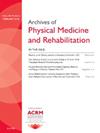Evidence for Care of Persons with Disorders of Consciousness: An Environmental Scan of Existing Guidelines, Policies, and Recommendations 8271
IF 3.6
2区 医学
Q1 REHABILITATION
Archives of physical medicine and rehabilitation
Pub Date : 2025-04-01
DOI:10.1016/j.apmr.2025.01.048
引用次数: 0
Abstract
Objectives
To identify existing guidelines, policies, and recommendations to guide care for persons with disorders of consciousness (DoC).
Design
An environmental scan of guidelines, policies, and recommendations for persons with DoC was conducted.
Setting
Four electronic databases (ie, Embase, Ovid MEDLINE, Scopus, and Cochrane) were searched by a medical librarian on May 25, 2023. Search terms were tailored for each database (eg, Ovid strategy: “clinical decision-making,” “guideline,” “consciousness disorders,” “consciousness,” “consciousness monitors,” “practice patterns,” “brain diseases,” “traumatic brain injuries,” “brain,” “consciousness disorders,” “diagnosis [maximizes sensitivity],” and “brain death”).
Participants
Written products (eg, guidelines, position statements) that guide clinician behavior for DoC (eg, coma, minimally conscious state) across etiologies (eg, traumatic brain injury, stroke) within a health care setting (eg, acute care, long-term care) were included. Case reports, literature reviews without recommendations, editorials, and brain death determination documents were excluded. Two reviewers screened titles and abstracts; articles with consensus for inclusion advanced to the full-text phase. Two reviewers independently reviewed the full text; articles with consensus for inclusion advanced to the data extraction phase.
Interventions
Two reviewers extracted the following data from articles that met criteria: publication information; document type and aim; etiology; population; age; setting; recommendation number, methodology, and evidence; quality assessment process; risk of bias assessment; and organizing group.
Main Outcome Measures
Not applicable (no intervention provided to measure).
Results
With publication dates spanning 1991 to 2020, 14 documents met inclusion criteria, including 9 from the United States, 3 from the United Kingdom, and 2 with international authorship. Most recommendations were relevant to adults with DoC after traumatic or nontraumatic brain injury (11/14). Pediatric patients were explicitly mentioned in 6 of 14 studies. The most common setting was acute care (10/14) with the least common settings being prehospital (1/14) and subacute rehabilitation (1/14). Recommendations relevant to diagnosis and prognosis (12/14) were most frequently included, followed by treatment/management (10/14), family/caregiver needs (8/14), policy/legal (8/14), research (7/14), and finally, ethics (3/14).
Conclusions
Most existing recommendations for care of persons with DoC are appropriate for acute care in the United Status after acquired brain injury. Most guidelines in DoC pertain to diagnosis/prognosis and treatment/clinical management. Gaps exist within each domain; however, there is a clear need for evidence-based guidelines regarding family/caregiver needs, ethics, policy/legal issues, and research for adult patients and in all domains for pediatric patients.
Disclosures
none.
求助全文
约1分钟内获得全文
求助全文
来源期刊
CiteScore
6.20
自引率
4.70%
发文量
495
审稿时长
38 days
期刊介绍:
The Archives of Physical Medicine and Rehabilitation publishes original, peer-reviewed research and clinical reports on important trends and developments in physical medicine and rehabilitation and related fields. This international journal brings researchers and clinicians authoritative information on the therapeutic utilization of physical, behavioral and pharmaceutical agents in providing comprehensive care for individuals with chronic illness and disabilities.
Archives began publication in 1920, publishes monthly, and is the official journal of the American Congress of Rehabilitation Medicine. Its papers are cited more often than any other rehabilitation journal.

 求助内容:
求助内容: 应助结果提醒方式:
应助结果提醒方式:


